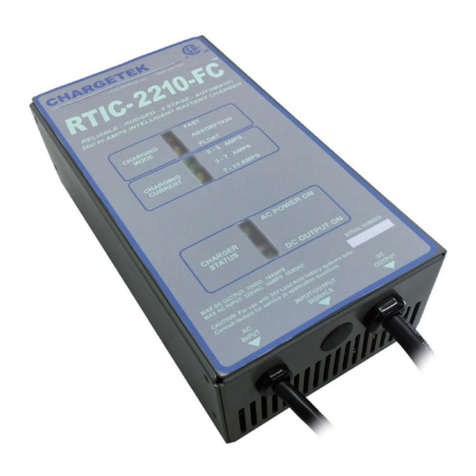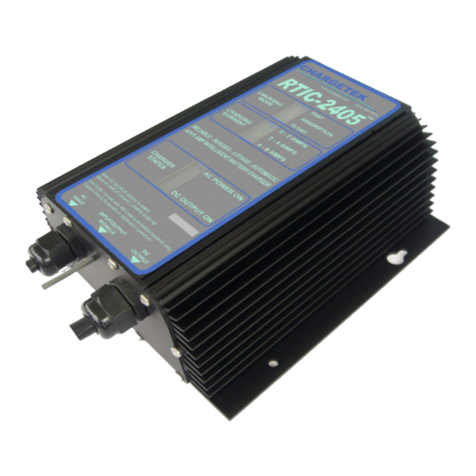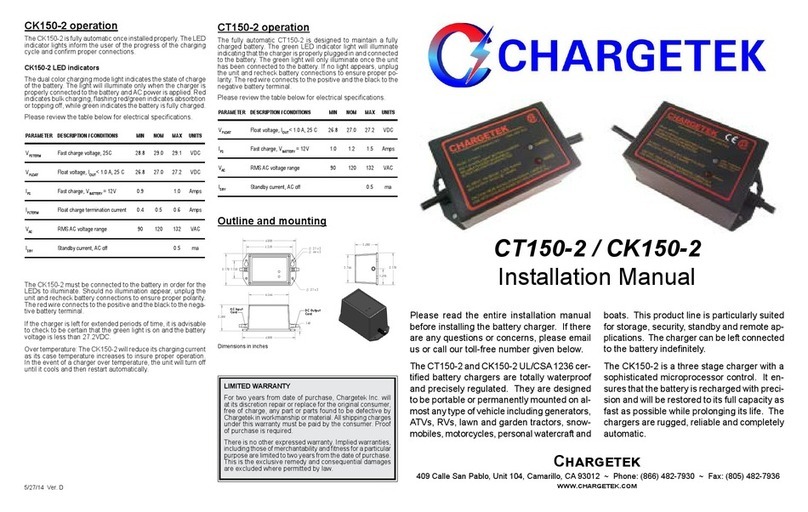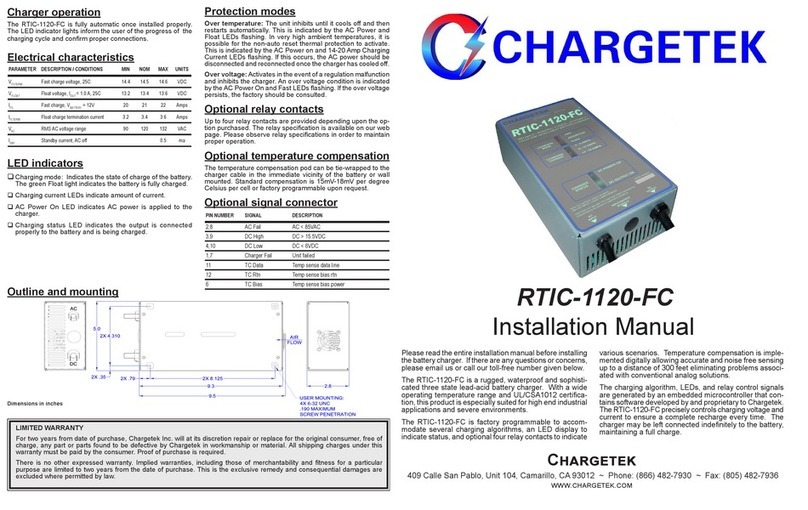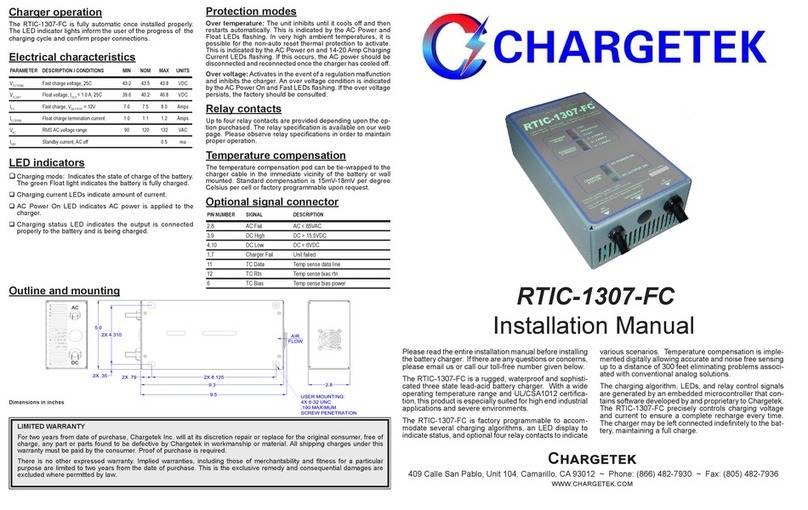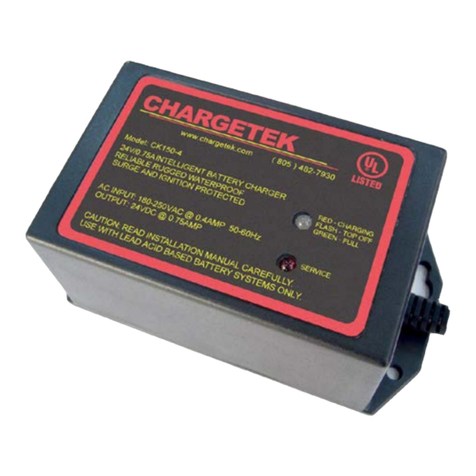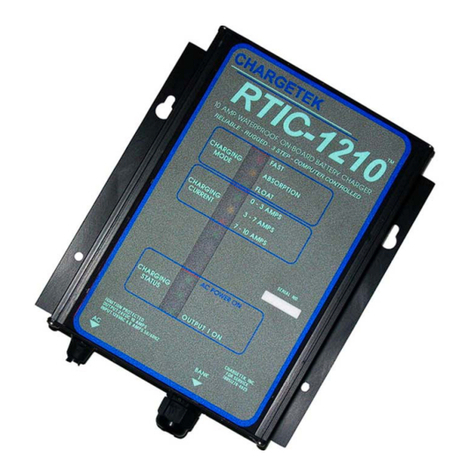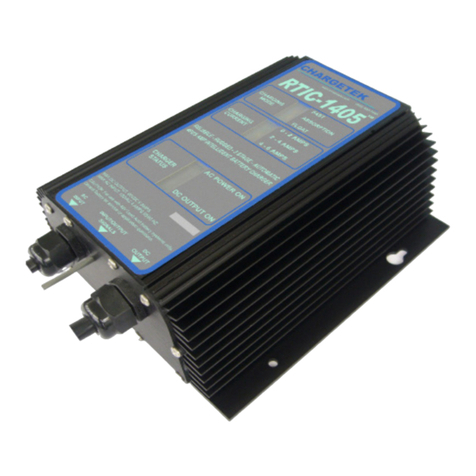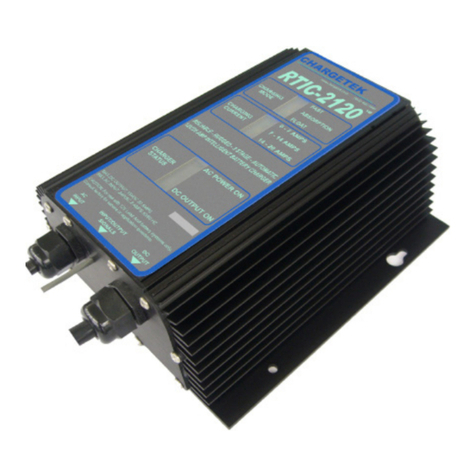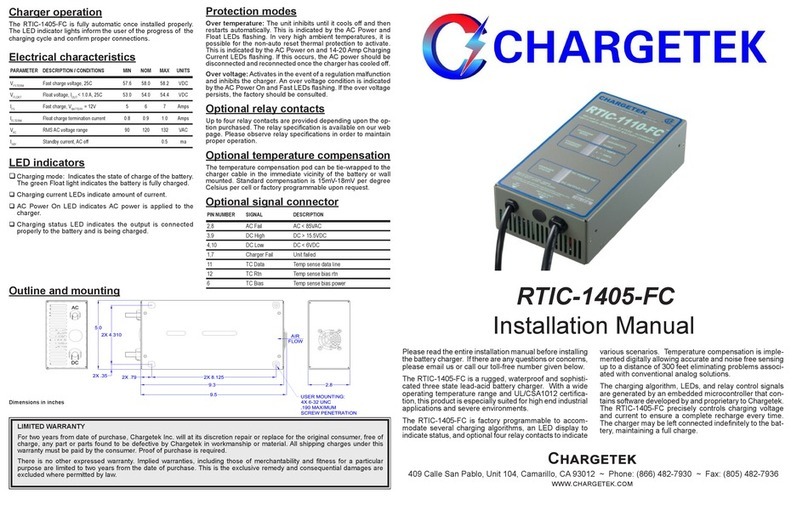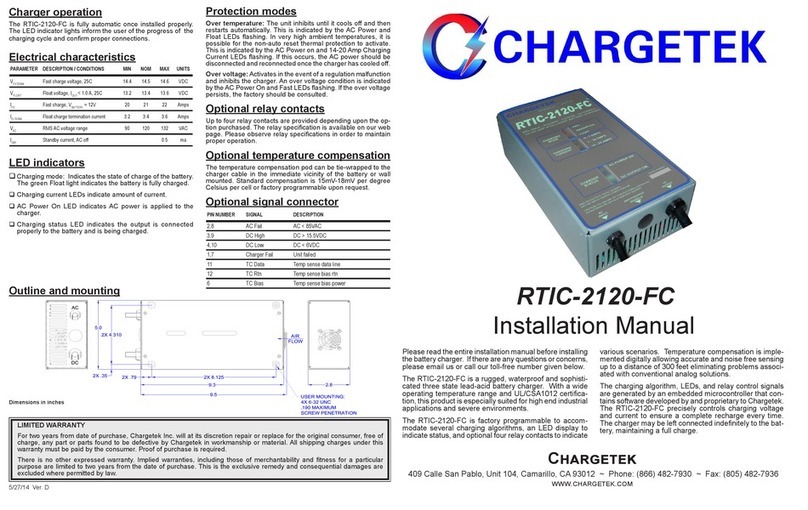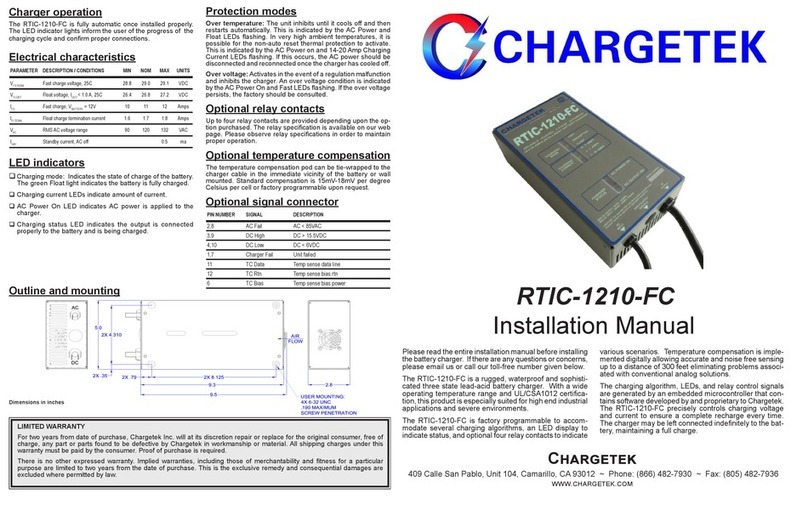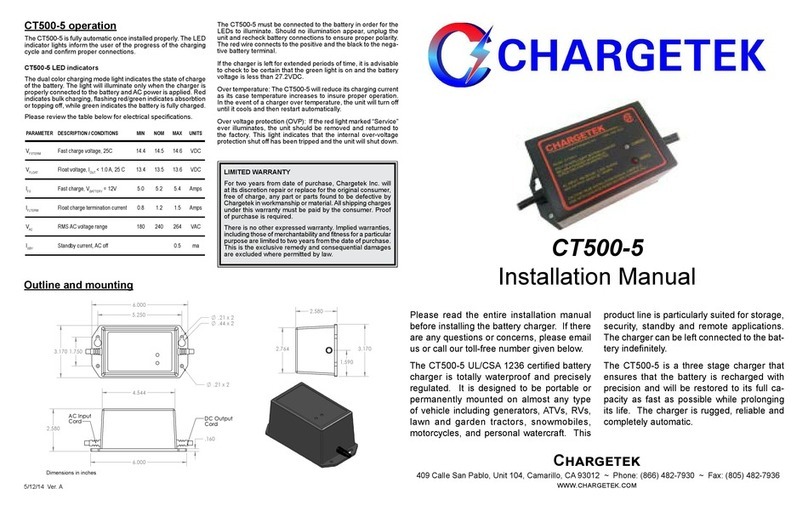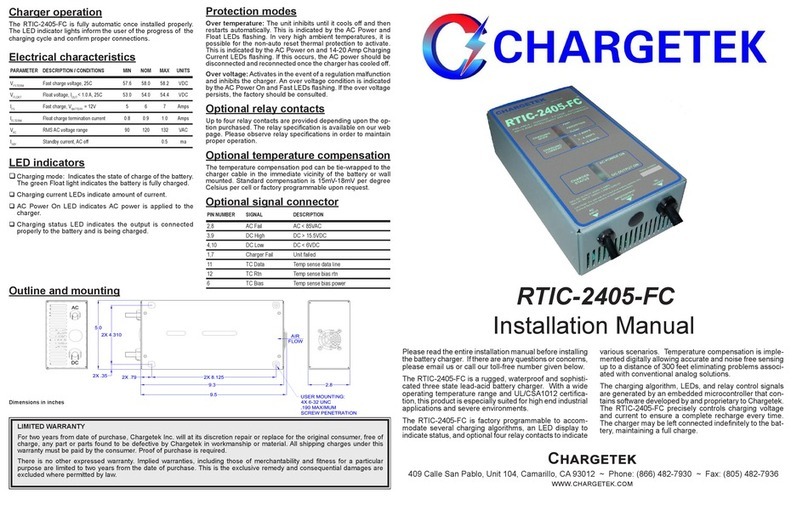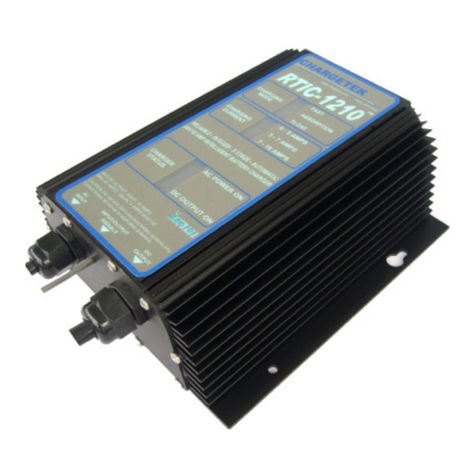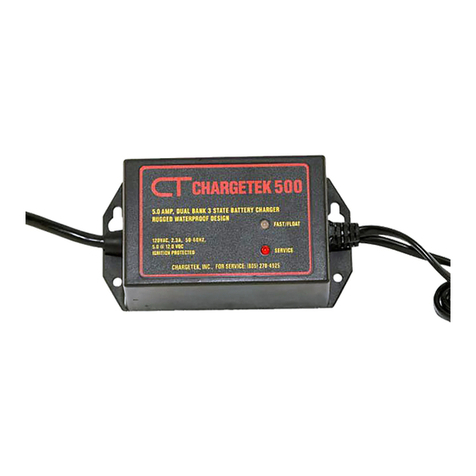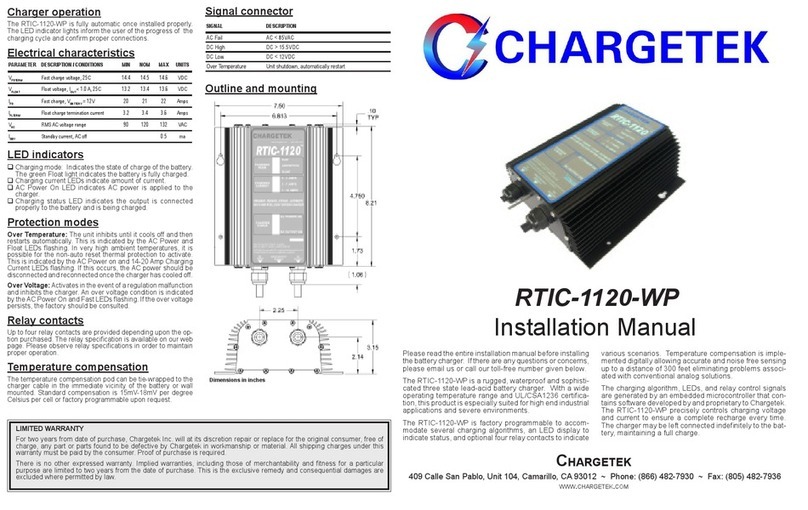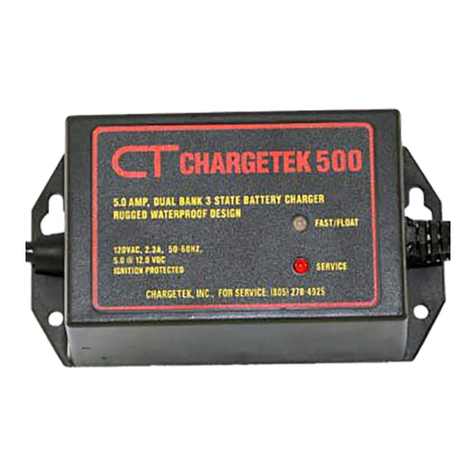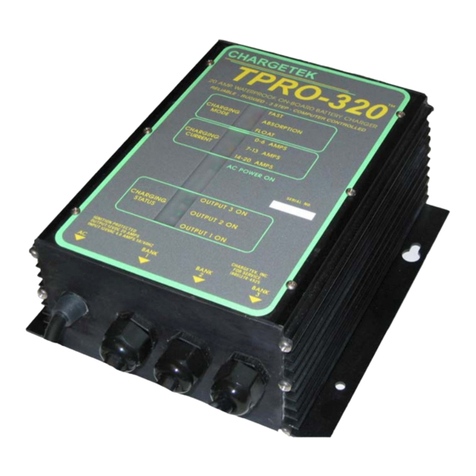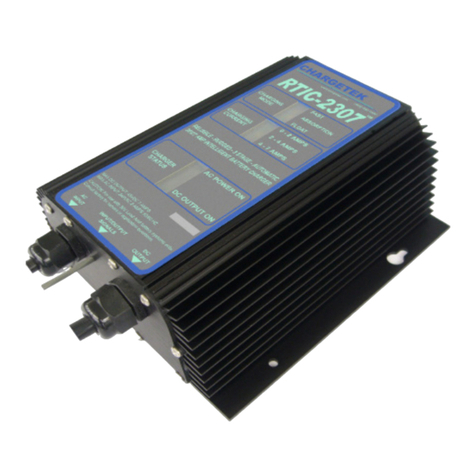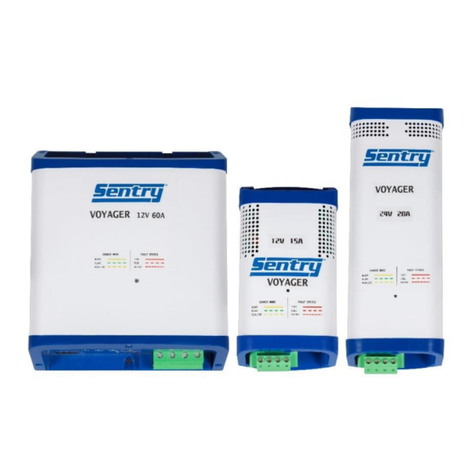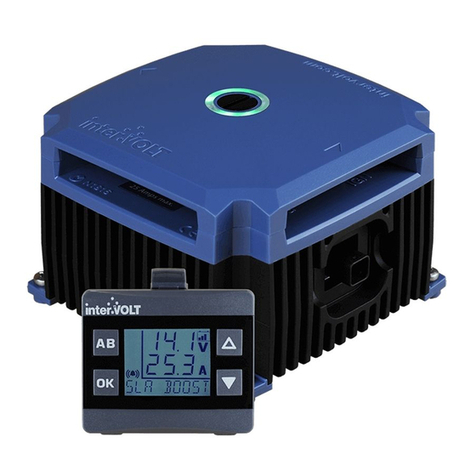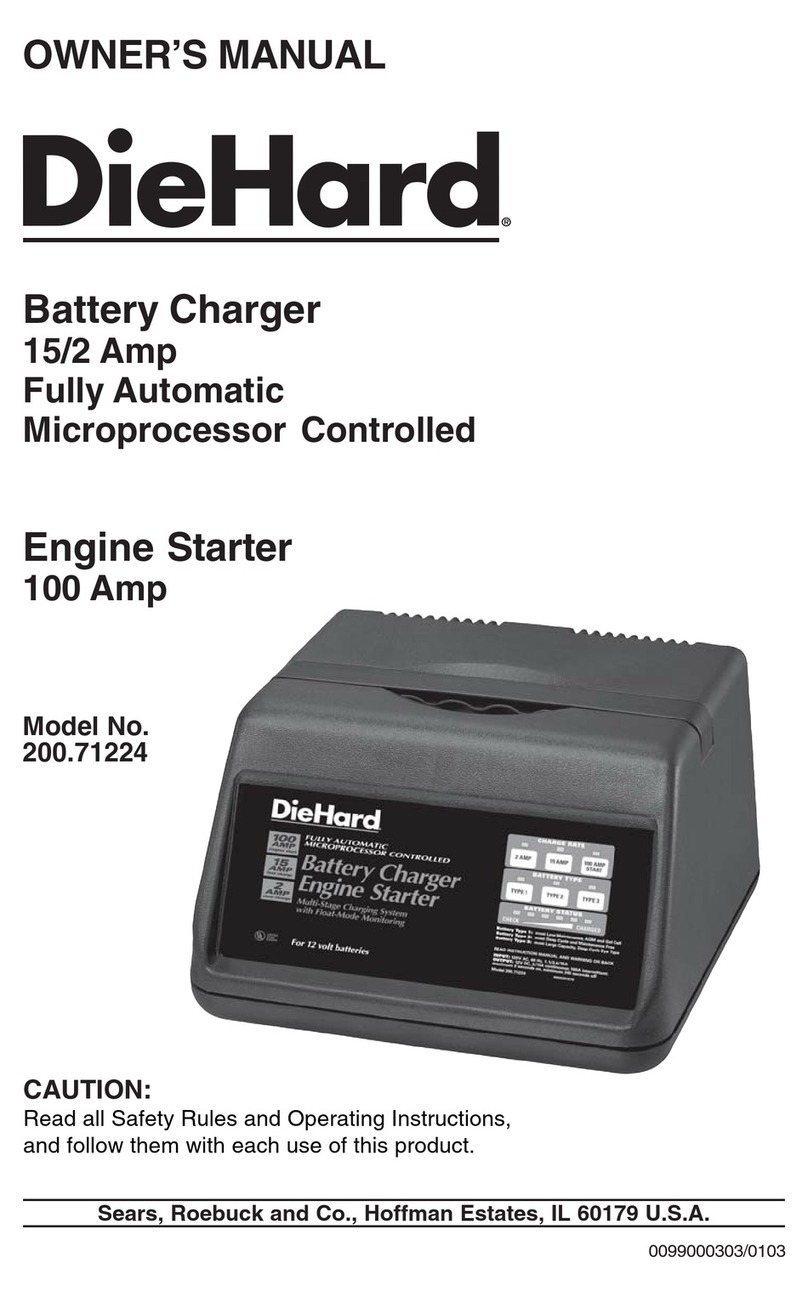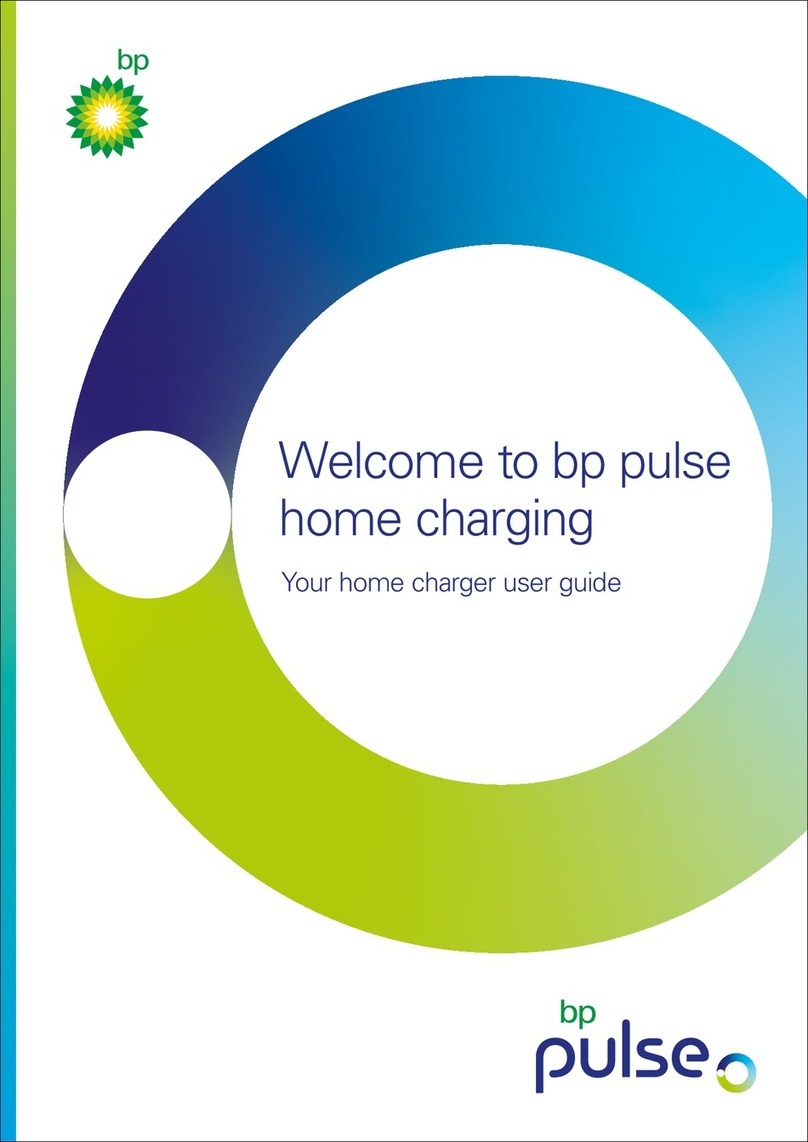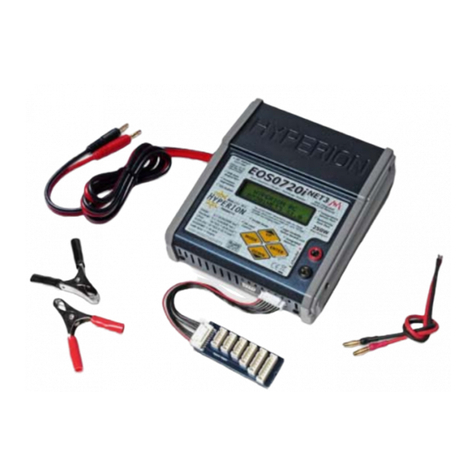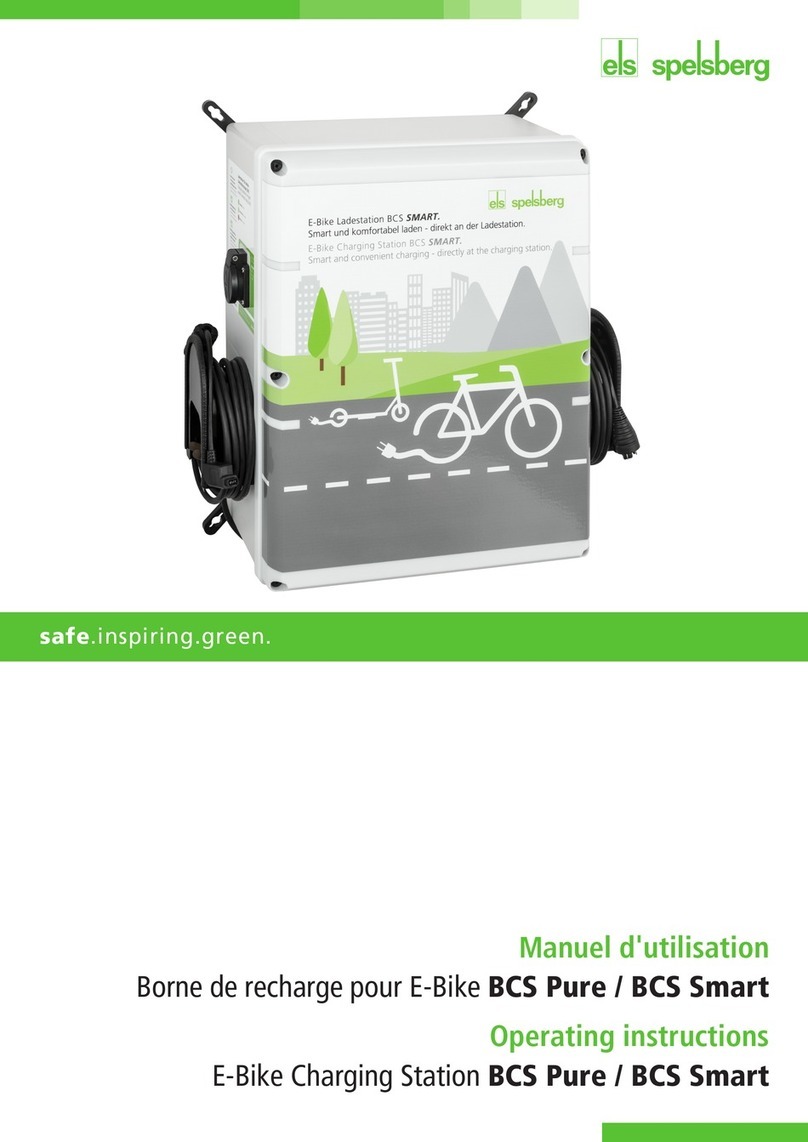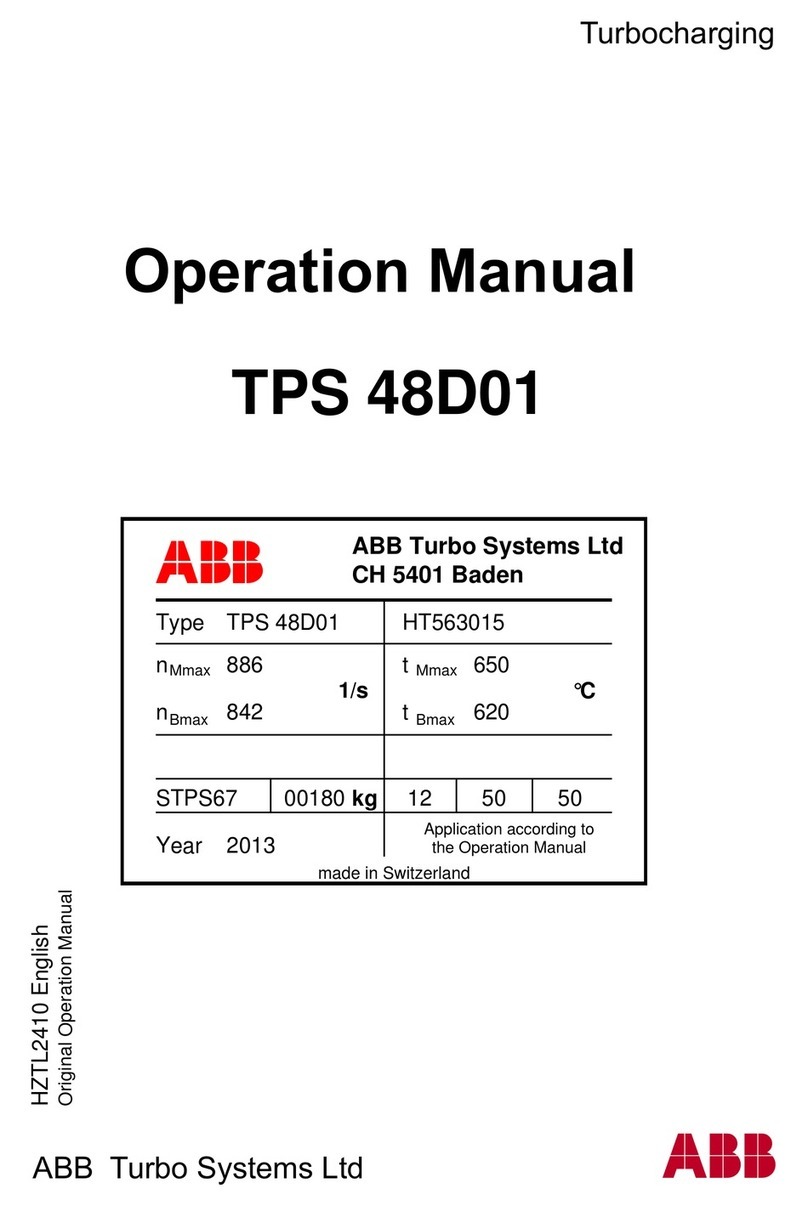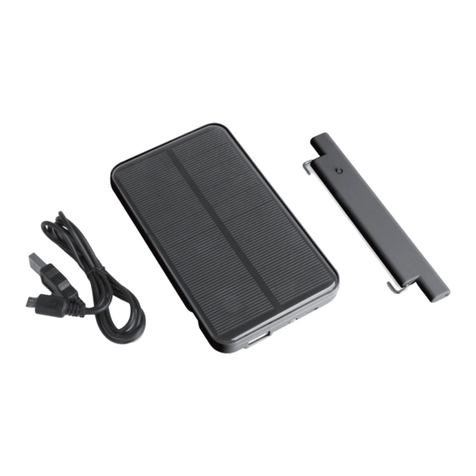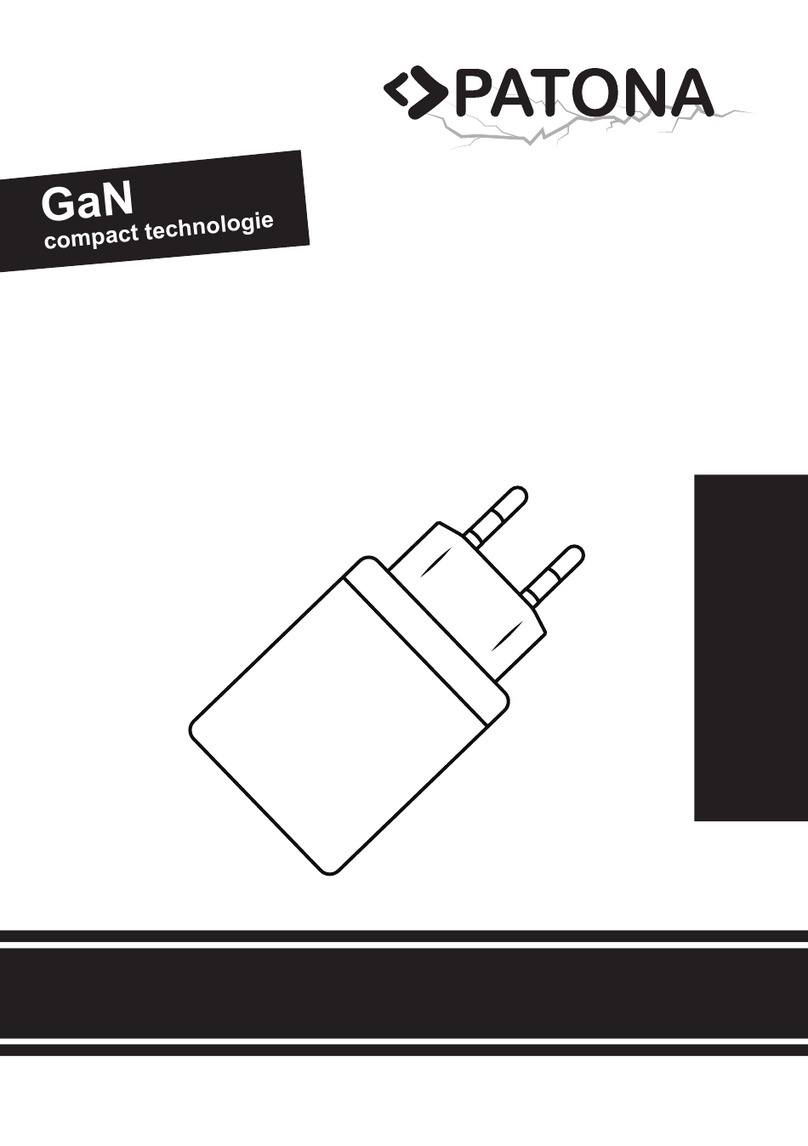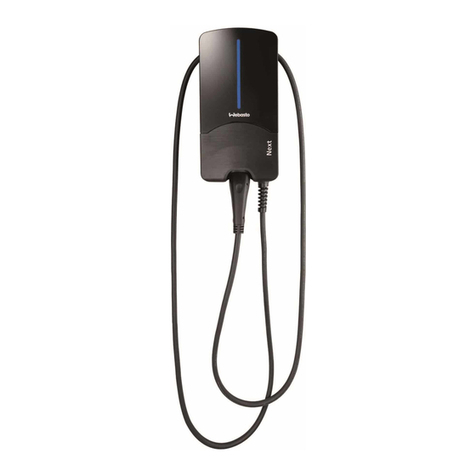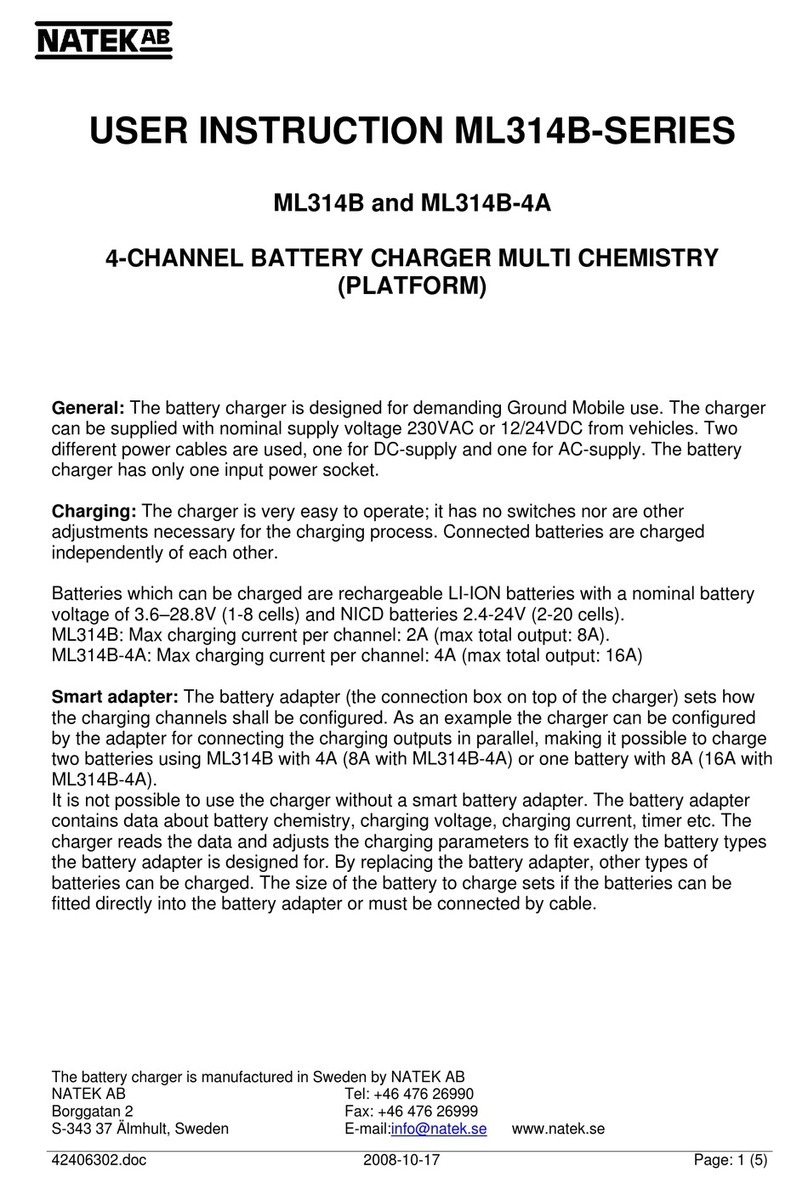INSTALLATION
LOCATION
Do not mount directly over or under a battery or onto a carpeted,
upholstered or varnished surface.
Install in an area where all charger electrical cords will avoid hot
surfaces such as exhaust pipes and moving parts such as fan wheels.
Operating ambient temperature is 15 to 130 degrees Fahrenheit.
Storage temperature is -20 to 160 degrees Fahrenheit.
Pick an area that will provide as much surrounding cooling
clearance as possible for maximum efficiency and shortest recharge
times.Maintain a 12 inch clearance around charger andnever mount
in the vicinity of explosives, pressurized cans or other flammable
material.
MOUNTING
Wear safety goggles, gloves and a long sleeve shirt when drilling
mounting holes near a battery.
In most cases, #10 stainless steel mounting bolts with aircraft nuts
or nylocks or #10 screws provide for solid mounting.
ELECTRICAL
DC WIRE CONNECTIONS
Each output should be connected only to a standard lead-acid bat-
tery.
DC wire connections must be made before plugging in the AC
cord. The charger will not operate until DC connections are made.
Do not remove DC connections while the AC cord is plugged in.
When installing in the bilge and or battery compartment of boats,
open hatches and operate bilge blowers if any for ten minutes to
remove any fumes and hydrogen gas. Be certain the area is
ventilated for personal health and safety
Keep wire routing from the charger to the battery neat and secure
by anchoring with cable tie to a solid surface every few inches, not
to exceed 18” intervals.
As is true with any device connected to a battery, an in-line fuse
added to the positive lead to the battery is recommended to pro-
vide protection if the DC cord is somehow damaged.
For a single 24 volt battery, connect the charger lead set to the
battery as follows; the charger red lead is connected to the battery
positiveterminal and the black chargerlead is connected to negative
terminal of the battery. When charging two 12 volt batteries
connectedin series connect the red lead of the chargerto the positive
terminal of battery #1. Connected the negative terminal of battery
#1 to the positive terminal of battery #2. Connect the black lead of
the charger to the negative terminal of battery #2.All connections
should be clean and tight. See installation diagrams.
When connecting two batteries in series it is imperative that the
amount of discharge be equal for both batteries or excessive bat-
tery voltage during charge will be occurresulting in an overvoltaged
battery. This will cause dangerous battery out gassing and destruc-
tion. For accurate charge balancing regardless of loading use the
TPRO220model or CT500 dual outputcharger.
ACWire Connections
Note:
The CT 500-2 is equipped with a factory installed 6’ grounded AC
cord. Though hook up is only a matter of plugging this cord into a
suitable extension cord, please follow the following precautionary
steps:
Insure that the AC cord cannot reach moving parts, lids, hoods,
etc. Secure with a cable tie to solid anchor point if necessary.
The charger will operate properly with either 115 volts 50 Hz or
115 volts 60 Hz AC input. Never use 220 volt service with this
unit.
CAUTION:
Never connect the AC plug into an electrical outlet when you are
wet or barefoot.
Single 24V Battery
Connection
SAFETY INSTRUCTIONS
CAUTION: The following are important safety instructions. Save
these instructions.
Charge only lead acid, (maintenance free or refillable), or “gel-cell”
rechargeable batteries. Other types of batteries may burst causing personal
injury and damage
Never smoke or allow sparks or flame in the vicinity of a battery.
Someone should be within range of your voice and close enough to come
to your aid when you are working near a battery.
Wear eye protection and clothing protection. Avoid touching eyes while
working near a battery.
Have plenty of fresh water and soap nearby in case battery acid contact’s
skin, clothing or eyes.
If battery acid contact’s skin or clothing, wash immediately with soap
and water. If acid enters eyes, immediately flood eyes with running cold
water for at least ten minutes and get immediate medical attention.
Never operate a charger with a damaged cord or plug. Wearing of AC and
DC cords, accidentally nicking or cutting the cords could result in sparking
and cause injury.
Never operate a charger that has been damaged in any way or try to
disassemble. Return to factory when service or replacement is required.
Incorrect reassembly may result in a risk of electrical shock or fire.
Become familiar with all instructions, specifications and cautionary
markings on chargers, batteries and equipment used. Only adults should
install and operate the charger. Children should be kept out of reach of the
charger and batteries it is charging.
When using an extension cord the CT 500-2 requires a quality grounded
extension cord of at least 16 awg wire size for cords up to 50’ and a
minimum of 14 awg for cords up to 150’.
Never unplug a cord by pulling on the cord itself.Always grasp the plug
when disconnecting the charger.
Even though the CT500-2 is waterproof and designed for harsh
environments, do not operate submerged.
Never charge a frozen battery. If the battery has an odor or is visibly
damaged disconnect charger and consult factory.
Study battery manufacturer’s precautions such as removing or not
removing cell caps while charging.
Keep batteries full. Add distilled water in each cell until it reaches levels
specified by battery
Keep battery terminals clean.Always unplug charger before cleaning and
be careful to keep corrosion from coming in contact with eyes.
Remove personal metal items such as rings, bracelets, necklaces, and
watches when working with a lead-acid battery. A lead-acid battery can
produce a short circuit high enough to weld a ring, etc. to metal, causing a
severe burn.
THREE STATE CHARGE CYCLE
The CT500-2 employs a three state charge routine. This is the
charging procedure most lead-acid battery manufacturers rec-
ommend to return full capacity efficiently and extend battery
life. Please refer to the figure Three State Charging Curve dia-
gram.
STAGE I: CONSTANT CURRENT CHARGING OR BULK CHARGE MODE
Assuming the battery is starting in a discharged state, the charg-
ing is operating in constant current mode, where the charger
current is maintained at a constant value and the battery voltage
is allowed to rise as it is being recharged. Approximately 80%
of battery capacity is returned in the constant current region.
STAGE II: ABSORPTION MODE
When the battery voltage reaches approximately 2.45 volts per
cell, or 29.4 volts for a 24V battery, the charger voltage is held
constant at this level and the battery current is allowed to re-
duce. This voltage is maintained until the charging current re-
duces substantially indicating a full charge.At this point the bat-
tery is fully charged.
STAGE III: FLOAT MODE
Float mode is the final stage of the charging routine. Float mode
is where the voltage on the battery is maintained at approxi-
mately 2.25 volts per cell, or 27.0 volts for a 24V battery. This
voltagewillmaintainthefullcharge condition in the battery with-
out boiling out electrolyte or overcharging the battery. When the
charger is in this mode all lights on the CT500-2 should be
green.
Two 12VBattery
Connection
